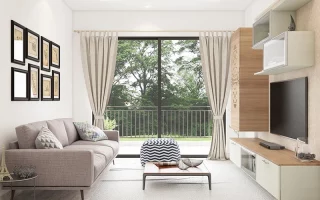Too big furniture will fight with room dimensions and look choppy and cluttered. Instead, opt for pieces that float like this sofa.
Opt for multifunctional furniture, like ottomans, that double as seating and storage. Having multiple uses for furnishings curbs clutter and allows the eye to scan the space, making rooms feel bigger.
Choose the Right Colors
Many think using bright, vibrant colors in a small living room is out of the question, but this doesn’t have to be the case. Using varying tones and shades of one color is a great way to make a room look well-thought-out, cohesive and visually larger.
If you use bright colors, opt for saturated jewel tones that shine in the sunlight and aren’t overpowering in the evening light. Cool earth tones, like emerald green or sapphire blue, can also be a great choice.
For wood furniture, avoid dark finishes as they can look heavy in a small space. Instead, consider a lighter wood that looks sleeker and more refined. You can also opt for tables that appear transparent or translucent rather than opaque, as these tend to be less imposing. Avoid cluttering your tables with too much decor by placing them away from walls and keeping the front feet of your furniture on the rug.
Go Multifunctional
It can be tempting to fill every corner of your living space with furniture, but this approach is more likely to make your room feel overcrowded and visually cluttered. Opt for slim upholstered living room furniture pieces and modular sectionals that can easily be reconfigured to keep things light and open. For a table, choose one that’s up on the legs instead of being tucked against the wall. This trick immediately opens up the floor and creates a more airy look.
Wayfair’s Resident Style Advisor Nadia McCowan Hill suggests going multifunctional with storage furniture for small spaces, such as an upholstered cube serving as a coffee table and footstool. Similarly, she says to use side tables that serve multiple purposes. An acrylic or lucite table takes up virtually no visual space and adds a stylish edge to modern living rooms, while a narrow console table works as both a desk and a table lamp holder.
Go for a Large Sofa
A large sofa may seem impossible in a small space, but that doesn’t have to be the case. The right design can work for a small living room if you opt for a piece in the right fabric and color that can blend with the surrounding walls. If you are worried about staining a light-colored sofa, try some stain-resistant performance fabrics available today that can stand up to kids and pets.
A sectional is a great choice for small spaces as it provides plenty of seating for guests without taking up much floor space. Look for options with long sides with plenty of seating and deep sides to place your feet up, or go for a modular style where the pieces can move around to suit the space.
Lighter wood finishes will also look less imposing than dark ones, and the furniture won’t visually compete with the ceiling or walls for attention. Another trick is to avoid bulky armrests and choose models with slimmer silhouettes that won’t crowd the frame and overtake a small space.
Consider Storage
The amount of storage you can incorporate into a room is crucial for smaller spaces. Consider coffee tables with built-in drawers and side tables with open shelves to show off your favorite objects. You can also invest in a storage footstool that doubles as both a coffee table and comfortable footrest, plus the lift-up lid reveals capacious storage.
Another way to add more storage is to mount shelving, benches and more on the wall. This helps to free up floor space and allows you to display framed photos, decorative mirrors and other accent pieces on the wall.
When choosing furniture for small spaces, it is also important to select slim and sleek pieces rather than bulky pieces. A table with fat-rolled arms or a multi-cushion back can appear visually inflated, making a room feel cramped. Similarly, tall and thin furniture rather than short and wide helps create the illusion of space.




